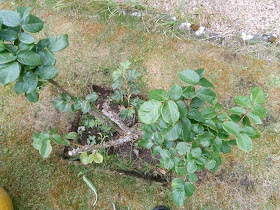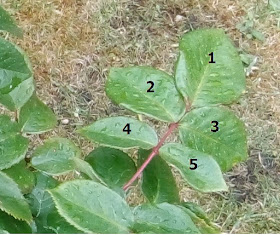Here's what you might call a FAQ: "how do I know if it's a Rose sucker, or just a proper shoot?"
I'll be writing about grafting and Roses again soon, but in the meantime, here's a quick reminder: many modern roses are grafted, ie they are two plants, joined together. The top part is the "beautiful" plant, bearing the flowers: the lower part is the "rootstock", which is usually something tough and sturdy, such as Rosa canina (Dog Rose).
It's really important to remove suckers which sprout from below the graft, because they won't be "beautiful" roses, they will be rootstock roses, ie common old Dog Rose. Which will speedily outgrow the "beautiful" rose!
How to tell the difference?
Here's a very old Rose, which is throwing up a couple of suckers at ground level.
"Where ?" you cry.
"How can you tell?" you cry.
Patience, my pets, I will annotate it for you.
There, that sprout under the pointy red arrow, that's a sucker.
How do I know? At first, the leaves on this plant all look the same, but if you look closely, there are a couple of differences.
And once you've seen them a few times, it gets very easy to spot them.
Firstly, make a general comparison between the leaves on the upper growth, and on that lower growth.
The leaves on the indicated shoot are a much paler green than those of the upper leaves, and they are much smaller,
Can you see the difference?
OK, so now you are shouting at the screen "But they might just be newer, and paler because they are small!" which is a valid point.
So as well as looking at the general colour and size, count how many leaflets there are on each leaf.
"Hang on," I hear you say, "What's all this leaf and leaflet business?"
Well, Roses have compound leaves - instead of having one big leaf, each of their leaves is divided into smaller parts, which are called, with a surprising clarity, not often to be found in botanical terms, leaflets.
And proper leaves have - usually - five leaflets.
Here is one of the leaves from the upper part of this Rose, and I have numbered the leaflets to make it clear.
There are five of them, one at the tip, and four more in pairs along the central rib.
Of course, sometimes leaves become damaged, and there might be a leaflet or two missing, but if you check a few of the leaves, you will find that, generally speaking, there will be 5 leaflets.
Now let's have a closer look at that sucker:
Aha!
There are 7 leaflets!
This is not an infallible indication: nature is very variable, and not all suckers will show 7 leaflets. Likewise, not all "proper" leaves will have 5 leaflets!
But on average, generally speaking, the number of leaflets is a good clue to look for.
So we can take these three elements together: the paler colour, the smaller leaflets, and the increased number of leaflets, and this can help us to decide whether new growth is a proper shoot, which should be encouraged: or whether the shoot is a sucker, and needs to be removed.
And once you've done it a few times, you will find it easier and easier to spot the infiltrators!
Did you enjoy this article? Did you find it useful? Would you like me to answer your own, personal, gardening question? Become a Patron - just click here - and support me! Or use the Donate button for a one-off donation. If just 10% of my visitors gave me a pound a month, I'd be able to spend a lot more time answering all the questions!!




No comments:
Post a Comment
Comments take around 2 days to appear: please be patient. Excessive SPAM has forced me to restrict comments to just Members: if you have a question, you can become a Member: or you can hop over to Patreon and join me there: or you can email me direct - my email address is in the right-hand pane. Sorry about this, but honestly, the spam! I'm drowning in it!!
Note: only a member of this blog may post a comment.